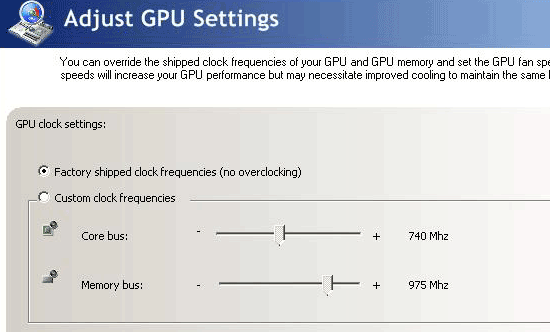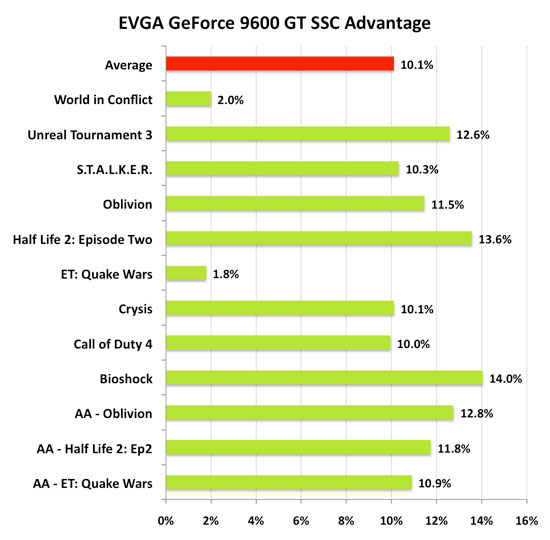When the Smoke Clears & Prices Settle: GeForce 9600 GT vs. Radeon HD 3870
by Anand Lal Shimpi on February 22, 2008 12:00 AM EST- Posted in
- GPUs
The Value in Overclocking: EVGA’s 9600 GT SSC
EVGA is currently shipping the highest clocked GeForce 9600 GT. Dubbed the EVGA GeForce 9600 GT SSC, this card runs its core at 740MHz and memory at 1.950GHz (data rate).
| Game | Stock GeForce 9600 GT | EVGA GeForce 9600 GT SSC | Percent Increase |
| Core | 650MHz | 740MHz | 13.8% |
| Shader | 1.625GHz | 1.835GHz | 12.9% |
| Memory | 1.80GHz | 1.95GHz | 8.3% |
You can buy this card directly from EVGA for $219.99, or if you shop around you'll shave off about $10, pricing it 12.6% higher than the average GeForce 9600 GT. Today's question? Is it worth it?

We ran the same benchmarks from the previous page on the EVGA GeForce 9600 GT SSC card and compared it directly to the stock GeForce 9600 GT:

The overclocked EVGA actually yielded some very healthy gains in the 10 - 12% range in most of our tests, the only exceptions being World in Conflict and Quake Wars which were both around 2%. On average, EVGA managed to boost performance approximately 10% after a 12.6% increase in board price.
Given that this is a price-sensitive mid-range part, any significant increase in price had better be more than worth its corresponding increase in performance. The problem is that at $208, you're only $10 away from an 8800 GT 512MB which should have no problems outperforming the 9600 GT. The 9600 GT makes the most sense at the $169 - $179 price range, and at those price points you're going to be dealing with stock clock speeds.










44 Comments
View All Comments
kilkennycat - Saturday, February 23, 2008 - link
Cashflow is not at all helpful if profits are negligible. That's a lot like being on a treadmill; lots of movement but getting nowhere.AMD's creditors are looking for neet profits to pay off their loans. From any production gross profits, AMD has first to recover the silicon DEVELOPMENT charges - probably at least $10million per silicon turn including chip test SETUP costs. And that is assuming that the silicon turn is just a minor variant on a current architecture - say fewer data-paths.
Since the AMD partners had to chop the RRP of the 3850/3870 by $50 -$70 then AMD probably had to absorb at least $40 average in a reduction of the price they charge their partners for the GPUs. I doubt if that leaves them any money at all above the GPU production costs to pay off their development overhead. Maybe Anand and crew can do a breakdown of the costs on a typical 3850/3870 board? I think that you will find that for the board partners to make any profit at all at the current retail prices, AMD cannot now be charging more than $50 - $60 per GPU. I suspect that packaging and final test for a GPU is in the $20 -$30 range, which leaves precious little money to pay for each yielded die, the necessary probe-test and all other handling overhead, and help pay off the interest and capital on their loans --let alone pay off the development expenditures. nVidia can afford thin margins for a long period of time; AMD in their current financial condition sure cannot.
Anyway, nVidia's next-gen GPUs are well into design, no doubt will make their appearance well before the end of this year, and until then I fully expect them to keep up the price pressure on AMD. And no doubt Intel will do the same once the full range of Penryn processors is available.
Zoomer - Saturday, February 23, 2008 - link
Don't forget that the higher end 3870 is using the same part, so economics of scale will play a part in reducing costs too.ATi hardware engineers rock.
razor2025 - Friday, February 22, 2008 - link
I'm not so sure AMD's losing money on their 3xxx series silicon with these price cuts. The underlying technology is still same as as the 2xxx series, with die-shrink and optimization as main R&D spent for the 3xxx series. Also, as long as their GPU is selling, they have the cashflow to continue their business. Sure, crushing debt is bad, but if you maintain the cash flow, it's still a viable business.The EVGA SSC is bad for the price/performance, especially considering that at you can get the MSI OCed 8800GT for mere $210 shipped at Newegg.
conorvansmack - Friday, February 22, 2008 - link
I'm looking forward to the comparison of the mid-range cards with an 8800GT. I still stuck deciding between an 8800GT and an 8800GTS that comes with Crysis. I guess I should hit the forums with this one.semo - Friday, February 22, 2008 - link
"Our testbed remained identical to what we used in our launch article"are you using 2 9775s or just one. it wouldn't make any difference in games either way, would it?
Anand Lal Shimpi - Friday, February 22, 2008 - link
That'd be 2 x 9775s, I've updated the test table. And no, they don't really make a difference in the games we're testing here today.Boushh - Friday, February 22, 2008 - link
'Neither card has a passively cooled reference design'Guru3D has reviewed a passivly cooled 9600GT from ECS with an Actic Cooler on it.
dcalfine - Friday, February 22, 2008 - link
That chart was made in Keynote or NumbersYou guys are all Mac users
(not that that's a bad thing)
Anand Lal Shimpi - Friday, February 22, 2008 - link
Close :)Microsoft Office 2008, on the Mac obviously.
SilthDraeth - Friday, February 22, 2008 - link
I am not sure how long you have been around here, but... Anand the guy the website is named after did a "month with a Mac" article quite a while ago, and has been using it since.